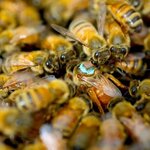Ecology & Zoology

Global warming did once kill off a once-common species, but it was the transition from the last Ice Age to the current warming period, starting 15,000 years ago.
That well-known species was the woolly mammoth but it managed to hang on until 2,000 B.C. Its last known habitat was Wrangel Island in the Arctic Ocean. Ice ages happen in cycles, in recent geological history about 90,000 of every 100,000 years the planet has seen the planet covered in far more ice, and during the last one, mammoths were widespread, from Spain to Alaska.
As global warming began 15,000 years ago, their habitat…

A decade ago there was concern about a mass die-off of bees, and while they rebounded nicely, it shone a light on a problem that has occurred since recordkeeping of bees first began over a thousand years ago. Mass die-offs are common.
While it was once believed to be just random bad luck, and modern environmentalists tried to claim it was pesticides in their war against agricultural scientists, the recent problems have instead been varroa mites.
These parasites are just a couple of millimeters in size but they infiltrate colonies and infect bees with viruses and do it will. Yet until…

Eight years ago I wrote about how environmental lobbyists working for environmental lawyer groups kept the federal government in such a tail-chasing frenzy nothing could ever really get accomplished.
My frustration was over the Paiute cutthroat trout, a rare High Sierra fish that everyone agreed needed help. The government agreed, sportsmen agreed, the courts agreed, environmentalists agreed, but then it was environmentalists preventing it from happening.
The federal government and the state wanted to restore this rare fish to its historical range, but environmentalists invoked the…

When we think of marsupials (carrying young in a pouch) they are small and cute (opossum, wombat) to a little more menacing (kangaroos in boxing gloves) but nothing like Palorchestid marsupials, an extinct group of Australian megafauna, who were large, had strange tapir-like skulls, and large claws.
Over the course of their evolution, palorchestids grew even larger and stranger. Using limb proportions as a proxy for body size, these authors estimated that the latest and largest of the palorchestids weighed over 2,000 lbs. Furthermore, their forelimbs were extremely muscular and were…

A team of ecologists exposed Zonotrichia leucophrys (white-crowned sparrows) to the seed treatment known as imidacloprid (in the class of insecticides known as neonicotinoids) and say the measured weight mass declined in just a few hours, which led to the birds delaying migration. But their study was so small it can only be considered exploratory.
Neonicotinoids are seed treatments, they were created to reduce broad spectrum spraying, like the dichloro-diphenyl-trichloroethane (DDT) that Nixon appointee William Ruckelshaus banned domestically over the findings of experts in 1972. But…

Though bees can live for years, their mating period is brief so male honeybees use a bee version of Flunitrazepam (Rohypnol - colloquially roofies) to improve their chances of being the successful dad. They inject vision-imparing toxins during sex that cause temporary blindness in females and keep them from flying off to other males.
The toxins identified in a new study are proteins contained in male bees' seminal fluid which helps maintain sperm. All honeybees make these proteins, though some may make more of it than others, and honeybee seminal fluid toxins can not only kill the sperm of…

Palaeontologists have discovered the world's largest parrot, standing up to 1m tall with a massive beak able to crack most food sources, and given it the name Heracles inexpectatus to reflect its Herculean myth-like size and strength and the unexpected nature of the discovery.
Being a giant in a country like New Zealand, well known for giant birds, is common. Moa dominated avifaunas but giant geese and adzebills shared the forest floor, while a giant eagle ruled the skies. But a giant extinct parrot? That is special.
The fossil is approximately the size of the giant 'dodo'…

Ever wonder why the slow moving sloth has a slightly greenish hue? Ever consider the sloth at all? Well, perhaps not. Location, location, location, is the mantra for many of us in our macro world, but it is also true for the small world of algae.
Blue green algae is a term used to describe any of a large, heterogeneous group of prokaryotic, principally photosynthetic organisms. These little oxygenic (oxygen-producing) fellows appeared about 2,000,000,000 to 3,000,000,000 years ago and are given credit for greatly increasing the oxygen content of the atmosphere, making possible the development…

Last week saw the release of the rebooted The Lion King, an attempt to capitalize on the billion-dollar success of the 1994 original. With a star-studded cast, the reboot closely follows the plot of the first movie (spoilers to follow, obviously).
Mufasa, king of the lions (and of every other creature in his territory), raises his son Simba to follow in his footsteps. But Mufasa is murdered by his jealous brother Scar, and his young heir is chased into the desert. Years pass, and eventually Simba reclaims his rightful place as the ruler of Pride Rock.
The remake is likely to be the box…

In a warming climate change scenario, higher mean temperatures may have an impact on plants and animals by disrupting their mutually beneficial relationship: The pasque flower (Pulsatilla vulgaris), for example, is sensitive to rising temperatures and will flower earlier, whereas one of its major pollinators, a solitary bee species, hatches at the same time.
Seed production will likely find a different route, this is two bee species out of about 25,000 after all, and the bee will switch to other plants to forage on.
None of that is devastating unless it doesn't happen the way evolution…